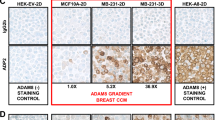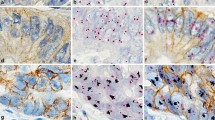Abstract
Studies of gene regulated by estrogen in breast cancer 1 (GREB1) have focused on mRNA levels with limited evidence about GREB1 protein expression in normal and breast cancer cells. A monoclonal antibody that recognizes GREB1 protein in breast tissues could be applied to correlate protein expression with established mRNA expression data. A hybridoma expressing a murine monoclonal antibody targeting a 119 amino acid peptide specific to human GREB1 was generated. The novel monoclonal GREB1 antibody (GREB1ab) was validated for use in Western blotting as well as immunohistochemical (IHC) applications. GREB1ab detects a 216 kDa protein corresponding to GREB1 in estrogen receptor alpha (ERα+) breast cancer cells as well as ERα− breast cancer cells transduced with a GREB1 expression vector. GREB1ab specificity was verified using an ERα antagonist to prevent GREB1 induction as well as a silencing siRNA targeting GREB1 mRNA. GREB1ab was further validated for detection of GREB1 by IHC in breast cancer cell lines and breast tissue microarrays (TMA). ERα+ cell lines were observed to express GREB1 while ERα− cell lines did not express detectable levels of the protein. Using breast cancer tissue whole sections, IHC with the GREB1ab identified protein expression in ERα+ breast cancer tissue as well as normal breast tissue, with little GREB1 expression in ERα− breast cancer tissue. Furthermore, these data indicate that GREB1 mRNA expression correlates well with protein expression. The novel monoclonal GREB1ab is specific for GREB1 protein. This antibody will serve as a tool for investigations focused on the expression, distribution, and function of GREB1 in normal breast and breast cancer tissues.






Similar content being viewed by others
References
Jordan VC (2003) Tamoxifen: a most unlikely pioneering medicine. Nat Rev Drug Discov 2(3):205–213
Rae JM, Johnson MD, Scheys JO, Cordero KE, Larios JM, Lippman ME (2005) GREB1 is a critical regulator of hormone dependent breast cancer growth. Breast Cancer Res Treat 92:141–149
Ghosh MG, Thompson DA, Weigel RJ (2000) PDZK1 and GREB1 are estrogen-regulated genes expressed in hormone-responsive breast cancer. Cancer Res 60(22):6367–6375
Johnson MD, Zuo H, Lee KH, Trebley JP, Rae JM, Weatherman RV, Desta Z, Flockhart DA, Skaar TC (2004) Pharmacological characterization of 4-hydroxy-N-desmethyl tamoxifen, a novel active metabolite of tamoxifen. Breast Cancer Res Treat 85(2):151–159
Bloom HJ, Richardson WW (1957) Histological grading and prognosis in breast cancer; a study of 1409 cases of which 359 have been followed for 15 years. Br J Cancer 11(3):359–377
Elston CW, Ellis IO (1991) Pathological prognostic factors in breast cancer. I. The value of histological grade in breast cancer: experience from a large study with long-term follow-up. Histopathology 19(5):403–410
Zabel U, Henkel T, Silva MS, Baeuerle PA (1993) Nuclear uptake control of NF-kappa B by MAD-3, an I kappa B protein present in the nucleus. EMBO J 12(1):201–211
Nedergaard L, Christensen L, Rasmussen BB, Jacobsen GK (1996) Comparison of two monoclonal antibodies for the detection of estrogen receptors in primary breast carcinomas. Pathol Res Pract 192(10):983–988
Press MF, Sauter G, Bernstein L, Villalobos IE, Mirlacher M, Zhou JY, Wardeh R, Li YT, Guzman R, Ma Y et al (2005) Diagnostic evaluation of HER-2 as a molecular target: an assessment of accuracy and reproducibility of laboratory testing in large, prospective, randomized clinical trials. Clin Cancer Res 11(18):6598–6607
Press MF, Slamon DJ, Flom KJ, Park J, Zhou JY, Bernstein L (2002) Evaluation of HER-2/neu gene amplification and overexpression: comparison of frequently used assay methods in a molecularly characterized cohort of breast cancer specimens. J Clin Oncol 20(14):3095–3105
Harvey JM, Clark GM, Osborne CK, Allred DC (1999) Estrogen receptor status by immunohistochemistry is superior to the ligand-binding assay for predicting response to adjuvant endocrine therapy in breast cancer. J Clin Oncol 17(5):1474–1481
Wolff AC, Hammond ME, Schwartz JN, Hagerty KL, Allred DC, Cote RJ, Dowsett M, Fitzgibbons PL, Hanna WM, Langer A et al (2007) American Society of Clinical Oncology/College of American Pathologists guideline recommendations for human epidermal growth factor receptor 2 testing in breast cancer. J Clin Oncol 25(1):118–145
Wolff AC, Hammond ME, Schwartz JN, Hagerty KL, Allred DC, Cote RJ, Dowsett M, Fitzgibbons PL, Hanna WM, Langer A et al (2007) American Society of Clinical Oncology/College of American Pathologists guideline recommendations for human epidermal growth factor receptor 2 testing in breast cancer. Arch Pathol Lab Med 131(1):18–43
Creighton CJ, Hilger AM, Murthy S, Rae JM, Chinnaiyan AM, El-Ashry D (2006) Activation of mitogen-activated protein kinase in estrogen receptor alpha-positive breast cancer cells in vitro induces an in vivo molecular phenotype of estrogen receptor alpha-negative human breast tumors. Cancer Res 66(7):3903–3911
Scaltriti M, Verma C, Guzman M, Jimenez J, Parra JL, Pedersen K, Smith DJ, Landolfi S, Ramon y Cajal S, Arribas J et al (2009) Lapatinib, a HER2 tyrosine kinase inhibitor, induces stabilization and accumulation of HER2 and potentiates trastuzumab-dependent cell cytotoxicity. Oncogene 28(6):803–814
Leung LK, Wang TT (1999) Paradoxical regulation of Bcl-2 family proteins by 17beta-oestradiol in human breast cancer cells MCF-7. Br J Cancer 81(3):387–392
Loi S, Haibe-Kains B, Desmedt C, Wirapati P, Lallemand F, Tutt AM, Gillet C, Ellis P, Ryder K, Reid JF et al (2008) Predicting prognosis using molecular profiling in estrogen receptor-positive breast cancer treated with tamoxifen. BMC Genomics 9:239
Singer CF, Kostler WJ, Hudelist G (2008) Predicting the efficacy of trastuzumab-based therapy in breast cancer: current standards and future strategies. Biochim Biophys Acta 1786(2):105–113
Acknowledgment
We gratefully acknowledge funding support in part by a grant from the Breast Cancer Research Foundation (Grant number N003173).
Author information
Authors and Affiliations
Corresponding author
Rights and permissions
About this article
Cite this article
Hnatyszyn, H.J., Liu, M., Hilger, A. et al. Correlation of GREB1 mRNA with protein expression in breast cancer: validation of a novel GREB1 monoclonal antibody. Breast Cancer Res Treat 122, 371–380 (2010). https://doi.org/10.1007/s10549-009-0584-x
Received:
Accepted:
Published:
Issue Date:
DOI: https://doi.org/10.1007/s10549-009-0584-x




